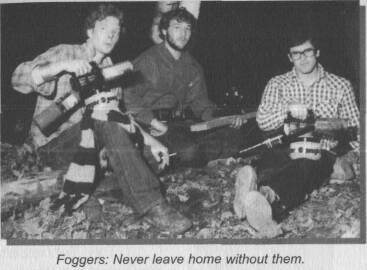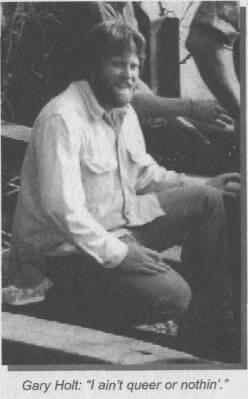If Chins Could Kill: Confessions of a B Movie Actor (18 page)
Read If Chins Could Kill: Confessions of a B Movie Actor Online
Authors: Bruce Campbell
Tags: #Autobiography, #United States, #General, #Biography & Autobiography, #Biography, #Entertainment & Performing Arts - General, #Entertainment & Performing Arts, #Actors, #Performing Arts, #Entertainment & Performing Arts - Actors & Actresses, #1958-, #History & Criticism, #Film & Video, #Bruce, #Motion picture actors and actr, #Film & Video - History & Criticism, #Campbell, #Motion picture actors and actresses - United States, #Film & Video - General, #Motion picture actors and actresses

NEW GUINEAS
Had these poor actors read the fine print at the bottom of their contract, they would have seen the disclaimer: "In addition, you will also be the guinea pigs for makeup testing. These heinous products have not been tested on animals, because they will be tested on you..."
The actors destined to portray possessed monsters in the film (four out of five), had to be fitted for Scolero contact lenses. These weren't your basic "soft," or "disposable" lenses for "sensitive eyes," these suckers were glass and, covering two-thirds of the eye --
big.
To get the idea, run to your kitchen and shove a Tupperware lid over your eyeball. Because the glass lenses prevented the eye from breathing, they could only be kept in for fifteen minutes at a time. Of course,
getting
them in took a full ten minutes, so this was a pretty neat trick.
As bad as it got during production, I could always nod to myself and chuckle,
At least I don't have to wear those stinkin' lenses.
I nodded a lot over the next twelve weeks.
Because a number of these possessed characters ultimately were dismembered, it was necessary to make plaster molds of various appendages. The makeup techniques we used at the time were not that far off from those used on the original
Frankenstein.
When things called for a plaster mold, we simply poured plaster of paris directly on top of Vaseline-coated skin -- who wouldn't?
Now, if you've ever had any experience with this form of plaster, you'd know that it heats up as it sets -- not a little... a
lot.
Betsy Baker, head coated in this stuff, unable to see, hear or talk, began to jot furiously on a pad of paper:
"Getting very warm . . . how much longer?"
Betsy's scrawls soon became more urgent: "Getting very light-headed... must get out soon!"
Using implements the Three Stooges would have been proud of, we liberated her from her tomb only to find a full set of eyelashes perfectly preserved in the plaster. Needless to say, we had some explaining to do.
And so the makeup tests plodded along, resulting in raw limbs from excessive heat and unwanted hair removal, and strained eyes from numerous attempts to "wear" Scolero lenses.
It was unquestionably an omen of things to come.
CREW WHO?
The ragtag behind-the-scenes group we conned into this adventure came from all walks of life:
Steve "Dart" Frankel -- he was very good with his hands. By way of carpentry, he became our art director. His hammer was affectionately referred to as "Uru." Sam had first met this mythical man at Camp Tamakwa, situated in the Algonquin Park of northern Ontario, Canada.
Dart was last seen in the South Island of New Zealand, working as a chiropractor -- still using his hands.
David "Goody" Goodman -- a longtime Raimi friend, Dave went all the way back.
"One time Sam was really being a pain in the ass. In their backyard they had those prong type fences, so once Ivan (Sam's brother) and I hung him on the fence by his pants and started spitting at him and hitting him and he was stuck on the fence and couldn't do anything. The housekeeper saw what we were doing and came out with a broomstick and started chasing us until we took him down."
During the course of this shoot, Dave will earn the dubious title of "the Filmmaker's Burden." His official job was chef.
Don "I wanna break stuff" Campbell -- Brother Don was a yahoo in search of an adventure. With no true interest in filmmaking, this was one of his few experiences on a set. His driving desire to work with us stemmed from the fact that "a lot of stuff was gonna get wrecked." Production assistants made $50 a week, so we couldn't be really picky.
John Mason -- sound man. He was an old teacher of mine during a very brief stint at Wayne State University, in Detroit. John quit teaching and left his family behind to work on this film. Go figure...
Tim Philo -- cameraman. He came from the same university as John Mason and had actually shot the better part of a feature film before.
What the hell,
we thought,
he seemed like a nice guy.
Josh Becker -- obviously, Sam and I had already "worked" with him for years. As the shoot intensified and crew members began to drop like flies, Josh, in his own irascible way, became a key player and distinguished himself as one of the few who went the distance.
Rob Tapert -- Mr. Producer. In those days, producer meant doing anything that nobody else was doing, or
would
do. This ran the gamut of fogging the background of a shot to pushing the wheelchair dolly.
That's the real beauty of having no budget -- the lines of
who does what
get very blurry. During production, when I wasn't acting, I'd toss a coat over my sticky, blood-soaked shirt and haul lights around.
Tom Sullivan -- makeup man. Tom was merely expanding what he had learned from our prototype,
Within the Woods.
Aside from baking actor's body parts and subjecting them to noxious substances, he was a nice, quiet guy.
Sam Raimi -- writer/director/boy genius. He was technically a teenager when we started the project and had just turned twenty when filming began. This film was his rite of passage. It was always fun to see what shade of gray Sam turned on any given day, depending on how few hours he had slept. I got a perverted comfort in knowing that as hard as he pushed the cast and crew, he always pushed himself just a little bit harder.
Rob, Sam and I were contracted, as executive producers, for $35 a week in expenses, which we never collected. We had never been paid on anything else, why start now? I recall attempting to buy a pack of gum during the shoot and realizing that I simply had no money to pay for it.
PICK A STATE, ANY STATE
We now had the cast and the crew, but where would we shoot the film?
Michigan had never been big on the "let's get Hollywood to film here" thing, so there were no formal agencies to assist in finding a location. We needed a house on a hill, a chasm and winding, rural roads.
We contacted the Michigan Travel Bureau, but nothing came of it. We even checked out a creepy suburban house we used to pass on our high-school bus, but since it was on the corner of two very busy streets, we decided to keep looking. Michigan was rapidly becoming out of the question -- daily frost and incessant drizzle confirmed that. It was the end of October already, and the only way to avoid assuredly inclement weather was to head south.
The Tennessee Film Commission, much to their credit, made the best case for shooting there. In fact, they were the
only
state that seemed to give a rat's ass.
On November 9, there was no going back. Ready or not (emphasis on
not
) we loaded up several cars and a truck and pointed the convoy south on Interstate 75.
Sam and Rob had scouted a location in the town of Morristown, Tennessee, about forty miles northeast of Knoxville. I'd like to say that it was sleepy or quaint, but it wasn't -- it was just a small town in rural America.
We managed to find a fairly large house several miles outside of town where everyone stayed -- thirteen people in all. With six bedrooms, it would work if most of us slept in groups.
Josh and Goodman became unlikely bedfellows:
Bruce: Where did you sleep?
Josh: I slept in that back bedroom with Goody. We were in the same bed.
Bruce: Ugh -- you shared a bed with Goodman?
Josh: I finally got to the point where he was so aggravating, I pulled the box springs out and I slept on the box springs and let him have the mattress. He was like some horrible monster.
When the crew later ballooned to seventeen, the accommodations became downright collegiate, averaging
2.83
persons per room. With actresses each rating a single room, we had to break out the cots and the living room took on a whole new meaning. Tom Sullivan, the odd man out, claimed the laundry room -- more on that later...
DEEP IN THE HEART OF...
One day, during our rushed preparations, I had to withdraw a chunk of cash from the local bank. It had the funniest smell. "This money smells like dirt," I said to the teller.
"Makes sense," she explained. "Folks around here still bury it in their backyard."
We weren't in Detroit anymore.
A cabin that had been secured from the previous scouting mission fell through at the last minute. This led to a mad rush to find a new location.
Enter Gary "Here's-the-deal-I-worked-out" Holt.
This man was our first introduction to the South, circa 1979. He was classic in every sense. His "entrepreneur" background consisted of record producing, "previously owned" cars and "Dwarf tossing." His "client," Percy Ray, was a diminutive black man who specialized in a mean "Mr. T" impersonation. Gary circulated Percy as a "tossee" in local bars. Apparently, good ol' boys were more than happy to pony up for the chance to chuck ol' Percy Ray as far as they could.
"It was all in good fun, y'unnerstand..." Gary would explain.
Gary had also worked as a chauffeur in Memphis way back when and had the privilege of driving Elvis on one mystical occasion. He explained it this way:




